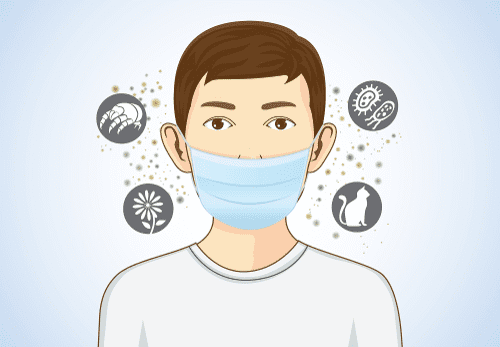General Guideline on Prevention of Novel Coronavirus Pneumonia published by the National Health Commission of PRC recommends surgical masks or N95 mask when going out in public, to seek medical treatment and to take public transportation[1].

Many people think that N95 mask works better, but in fact, the seemingly "loose-fitting" surgical mask is also very reliable, even more in line with the current mood of "free flying".
In this paper, we invite physicists and doctors to reveal which kind of mask is better from the perspectives of fluid mechanics (air is classified as fluids) and the medical point of view. Finally, in addition to bringing out facts and reasons, there is a big "surprise" verifying the real world at the end.
How does the air move while sneezing or coughing?
First of all, we should know how the air moves when we sneeze or cough.
People use hundreds of muscles when they sneeze or cough. At this point, the air in the lungs will be suddenly released, producing a fast and strong jet from the mouth or nose. The total gas jet generated by a sneeze will exceed 1 L sometimes, with the speed as high as 40 km/h, which is equivalent to the speed of a car in the city[2].
In such a strong jet, the liquid with virus and bacteria will experience two morphological changes: splitting and vaporization, resulting in different sizes of liquid particles, including aerosols of micron size.
In the natural state, while coughing or sneezing, most of the larger droplets will fall within 1 ~ 2 meters, while the smaller droplets can float 6-8 meters away and stay in the air for 10 minutes[3].
Analyze the effect of the abovementioned two masks through the principle of action
There are two main purposes of wearing masks: To prevent the virus from "spreading" and to prevent the virus from "being inhaled". Now we will analyze the two masks from these two aspects.
First, to prevent the virus from spreading is the anti-spreading function.
It aims at protecting others. When people breathe quietly, the danger of virus leaking from masks worn by people is not as high as that of sneezing. Briefly speaking, the virus can not spread far even if there is any.
Let's compare the anti-speading effect of the two kinds of masks on air flow.
First of all, for airflow ahead, there is little difference between surgical masks and medical N95 masks in blocking virus. They can reduce the amount of virus dozens of times, and keep the virus far away from the opposite people [4]. What about the air flow around ( from top to bottom, both sides)? N95 masks do have better sealing when breathing quietly. But N95 mask, like the surgical mask, will permit air to enter while coughing and sneezing because of the great pressure generated by the air flow.
Summary:
- Generally speaking, N95 mask has better anti-spreading function under quiet breathing.
- However, when the person wearing the mask coughs or sneezes, N95 mask is no better than the surgical mask on anti-spreading[5].
Second, prevent the virus from being inhaled. It is mainly to prevent the virus invasion.
As to this problem, we have to talk about how masks work:
First of all, the mask is like a sieve. Dust particles or pathogens larger than the diameter of the mask with microporous structure will be "stuck" and unable to pass through.

Secondly, the mask also has the function of "trapping" and "adsorption". For particles smaller than the diameter of the mask with microporous structure, the mask can also work as a "trapper" and "adsorber":
- In fact, the so-called trapper works because small particles move randomly, and "bump" on the mask material when flowing into the mask along with air as the mask material has relatively large area. At this point, these small particles are trapped on the mask due to the attraction between molecules (called Van der Waals force in Physics).
- The so-called adsorber refers to the electrostatic adsorption capacity of the mask. Tiny particles (3 µm in diameter) are often electrified and will actively adsorb onto the object. The masks are made of electrostatic materials, so as to play and enhance the electrostatic adsorption capacity. Based on these principles, masks can also absorb pathogens (such as viruses) with a diameter less than 0.3 micron. Sometimes, their filtration efficiency is even higher than that to large particles.
With three "capabilities" above, the mask can block not only particles larger than its own micropore, but also particles smaller than the micropore diameter.
So, what are the protective effects of surgical masks and N95 masks? Let’s analyze the protective effect of both based on their design criteria.
- Surgical masks can filter 95% of 3-micron particles and only 30% of 0.3-micron particles.
- N95 mask can filter 95% of 0.3-micron particles.
In some studies, experiments were carried out with "breathing" dummies to further verify this standard and observe the protective effect of both masks for dummies. One used artificial salt particles to simulate pathogens and other particles[6], and the other used aerosols of MS2 virus, which is harmless to humans but much smaller than the 2019-nCOV[7].
The results show that N95 mask is better than surgical mask in preventing virus inhalation, and has even 10-fold protective efficiency in some cases[6].
Conclusion: N95 mask is more effective in preventing virus inhalation.
However, the test result of the study involving 2000 people in real world is......
As is said above, you may feel that the effect of the both masks is clear to you. Don't worry, please take a look at the results of the following tests.
In 2019, CDC of the United States published a high-level mask comparison study on the internationally renowned Journal of the American Medical Association (JAMA). The study, with 2371 medical workers participated, lasted for 4 years and was conducted every year for 12 weeks at the peak of the flu season. This study draws the conclusion that there is no substantial difference in the proportion of infection with influenza virus between medical workers who wear N95 masks and those wearing surgical masks[8].
In fact, Hong Kong scholars published research in 2003 that supported the surgical masks. This study also shows that there is no actual difference in the proportion of infection with virus between more than 200 medical workers who worn N95 masks and surgical masks and had a close contact with SARS patients[9]. Of course, the study also finds that paper masks were ineffective.
Conclusion: There is no significant difference in the proportion of infecting with influenza or SARS between people wearing N95 masks and those wearing surgical masks.
Why are the two conclusions different?
The above two analysis conclusions show that the protective effect of N95 is better, but why do the real protective effect is almost the same?

Although there are no more studies supporting this, the following reasons may be speculated:
First, it's hard to wear N95 masks for a long time. N95 mask has better disease prevention effect, but poor air permeability and high respiratory resistance. Many people can't wear it for a long time, especially those with poor pulmonary function (such as the elderly and pneumonia patients) and children, it's difficult for them to wear it for a long period of time.
Second, it is more difficult to correctly wear N95 medical mask. It needs to carefully check whether the mask fits on the face around the edges.
Third, the statistical sample size may not be large enough, so the real difference between the two masks is not reflected. For example, the 2019 US CDC study also concluded that it may require 10000 person quarters (the number of participants multiplied by the number of flu seasons) for the test to be accurate enough.
Therefore, from the existing evidence we believe that: insisting on and correctly wearing surgical masks can achieve good protective effects. There is no need to pursue N95 mask.
Surgical masks also have the following advantages:
- Cheap.
- Comfortable: Surgical masks can be divided into over-the-ear and lace-up masks. The over-the-ear mask is convenient to use, with the elastic belts on both sides of the mask hung on the ears easily. And the surgical mask with a tie can control the tightness of the mask.
- Better ventilation, more suitable for people: for children and the elderly who don not "insist on" wearing the mask, N95 mask has a large respiratory resistance and is obviously more "incompatible", while surgical mask has better ventilation and is easier to use.
To sum up: It is not necessary to wear N95 masks in daily life. As long as the surgical masks are worn consistently and correctly, they can effectively prevent the virus spread and penetration.
References 9
[1] Gupta JK, Lin CH & Chen Q. Flow dynamics and characterization of a cough. Indoor Air, 2009, 19, 517–525.